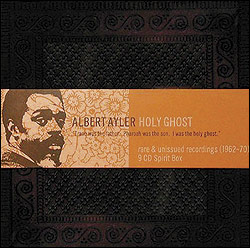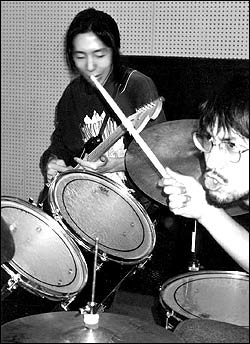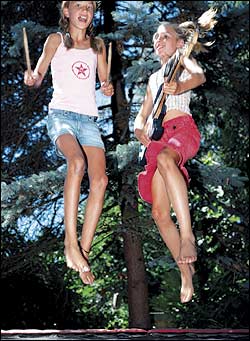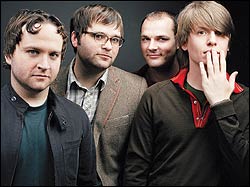A HORN SECTION in a band always sends a message. If a trumpeter or saxophonist takes a solo or plays as part of a group, it’s just another instrument. Put two or three or more horns together, though, and suddenly a band is a band with horns. The mass of brass commands attention; it implies discipline and strength. There’s something nearly military about it, something that suggests an order imposed on a band from above. Horns can make a singer sound like a hero in front of a fine-tuned machine, or like part of the machine itself. Beyoncé Knowles claims, in a recent interview with mMode magazine, that her record company liked “Crazy in Love” when they first heard it, “but they weren’t sure about the horns.” They were wrong, of course—the unison blasts that announce the song and punctuate it all the way through throw the spotlight on Beyoncé as surely as a thousand Vegas lights—but their worries were understandable.
To understand why, check out the way the horn sections function on two versions of Diana Ross’ disco hit “I’m Coming Out.” The recent “deluxe edition” of her album Diana (Motown/Chronicles) includes both the record as it was released by Motown in 1980 and the original mix approved by writer-producers Nile Rodgers and Bernard Edwards of Chic (and scrapped on the grounds that it sounded too much like Chic and too little like Ross).
In both “I’m Coming Out” mixes, trombonist Meco Monardo—best known for his discofied version of the Star Wars theme—takes a long solo in the middle. (It’s woozy, tone-bending, and a little off-rhythm. Nothing guides it but the song’s chords.) Chic’s version, though, follows Monardo’s solo with an acrobatic horn-section tattoo that runs through a long chorus; Russ Terrana’s mix for Motown strips almost all of those horns away to reveal Rodgers’ chiseling rhythm guitar part. The horns’ workout at the beginning of the song is mixed down by Terrana, too, and augmented with Ross singing the title a few more times. In Chic’s mix, she’s just the lead vocalist; in Motown’s mix, she’s the star.
THE POWER OF A HORN section allowed Chris McGregor’s Brotherhood of Breath to make a career out of toying with the tension between the moments when the horns played together and when they didn’t. The late pianist McGregor originally formed a racially integrated 17-piece big band in South Africa in 1963, but they weren’t welcome there under apartheid. The core members subsequently moved to Switzerland, then to London, England, where (in 1970) they formed the Brotherhood of Breath—a sui generis group that drew on South African pop, hints of American funk rhythms, and the open, exploratory impulses of free jazz. The group’s Bremen to Bridgwater (Cuneiform) documents three concerts from 1971 and 1975, when the lineup included the fondly remembered South African trumpeter Mongezi Feza and, sometimes, British saxophonists Gary Windo and Evan Parker.
The Brotherhood’s horn section splinters apart and crashes back together dozens of times in the course of two discs. On pieces like “Think of Something,” the nine horn players roll and sway through a tight, kinetic opening passage, then fall out of formation on cue, each barreling off in a direction of his own. After a few minutes, though, they start to join forces again, briskly restating the theme, then hopping onto and jumping off of the composed arrangement as it suits them. They’re going to conquer by their numbers, and damned if they’re going to march in formation unless they feel like it. Occasionally, they finish a song with an Ornette Coleman-style high-speed quotation of the theme, but McGregor is just as likely to send them thundering off onto a new piece with a flurry of piano.
STILL, IT’S possible to turn horn-section orthodoxy upside down. Maher Shalal Hash Baz are named after Isaiah’s son from the Bible, a name that literally means “the spoil speeds, the prey hastens”—or, as leader Tori Kudo puts it, “be quick if you steal something.” Kudo split off from a radical Japanese political group 20 years ago when they planned to assassinate the emperor. The 41 songs on MSHB’s new Blues du Jour (Geographic/ Domino) feature a peculiar horn section of euphonium and soprano saxophone, as well as the occasional flute or clarinet. The band seems to struggle to make it from one end of each song to the other—most collapse within a minute or two, and none manages to keep a consistent rhythm. (The tunes often meander into loveliness, though; the effect is a little like the what-are-we-playing-again? outtakes from the Beatles’ “Get Back” sessions, but with mystical/ Christian overtones.) Still, MSHB’s horns are right there with them every step of the way—which is to say that they can’t find their feet, either. They’re sloppy, way out of tune, and lovable like a hand-sewn doll. There’s nothing commanding about them. They don’t sound like victorious brass, marching in formation; they’re a few uncertain people, pushing whatever air they can summon from their lungs through tubes of bent metal, and their human frailty is the only message they have to deliver.








